
The Celts or Celtic peoples were a collection of Indo-European peoples in Europe and Anatolia, identified by their use of Celtic languages and other cultural similarities. Major Celtic groups included the Gauls; the Celtiberians and Gallaeci of Iberia; the Britons and Gaels of Britain and Ireland; the Boii; and the Galatians. The relation between ethnicity, language and culture in the Celtic world is unclear and debated; for example over the ways in which the Iron Age people of Britain and Ireland should be called Celts. In current scholarship, 'Celt' primarily refers to 'speakers of Celtic languages' rather than to a single ethnic group.
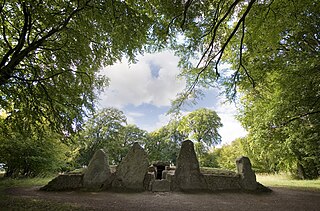
Long barrows are a style of monument constructed across Western Europe in the fifth and fourth millennia BCE, during the Early Neolithic period. Typically constructed from earth and either timber or stone, those using the latter material represent the oldest widespread tradition of stone construction in the world. Around 40,000 long barrows survive today.
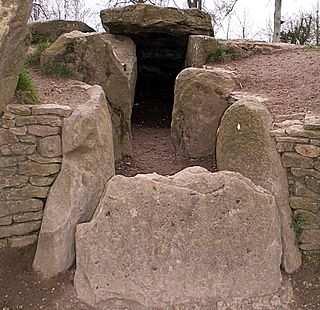
The Cotswold-Severn Group are a series of long barrows erected in an area of western Britain during the Early Neolithic. Around 200 known examples of long barrows are known from the Cotswold-Severn region, although an unknown number of others were likely destroyed prior to being recorded.

Atlantic Europe is a geographical term for the western portion of Europe which borders the Atlantic Ocean. The term may refer to the idea of Atlantic Europe as a cultural unit and/or as a biogeographical region.
"Widsith", also known as "The Traveller's Song", is an Old English poem of 143 lines. It survives only in the Exeter Book, a manuscript of Old English poetry compiled in the late-10th century, which contains approximately one-sixth of all surviving Old English poetry. "Widsith" is located between the poems "Vainglory" and "The Fortunes of Men". Since the donation of the Exeter Book in 1076, it has been housed in Exeter Cathedral in southwestern England. The poem is for the most part a survey of the people, kings, and heroes of Europe in the Heroic Age of Northern Europe.

Archaeology and geology continue to reveal the secrets of prehistoric Scotland, uncovering a complex past before the Romans brought Scotland into the scope of recorded history. Successive human cultures tended to be spread across Europe or further afield, but focusing on this particular geographical area sheds light on the origin of the widespread remains and monuments in Scotland, and on the background to the history of Scotland.

Cup and ring marks or cup marks are a form of prehistoric art found in the Atlantic seaboard of Europe (Ireland, Wales, Northern England, Scotland, France, Portugal, and Spain – and in Mediterranean Europe – Italy, Azerbaijan and Greece, as well as in Scandinavia and in Switzerland.
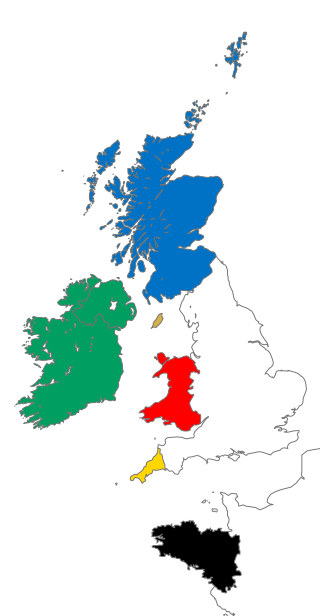
The modern Celts are a related group of ethnicities who share similar Celtic languages, cultures and artistic histories, and who live in or descend from one of the regions on the western extremities of Europe populated by the Celts.
Caroline Ann Tuke Malone is a British academic and archaeologist. She was Professor of Prehistory at Queen's University, Belfast from 2013 and is now emeritus professor.
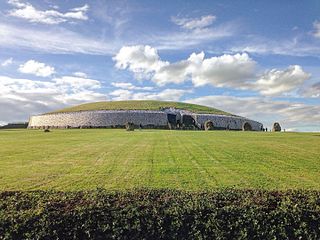
The prehistory of Ireland has been pieced together from archaeological evidence, which has grown at an increasing rate over the last decades. It begins with the first evidence of permanent human residence in Ireland around 10,500 BC and finishes with the start of the historical record around 400 AD. Both the beginning and end dates of the period are later than for much of Europe and all of the Near East. The prehistoric period covers the Palaeolithic, Mesolithic, Neolithic, Bronze Age and Iron Age societies of Ireland. For much of Europe, the historical record begins when the Romans invaded; as Ireland was not invaded by the Romans its historical record starts later, with the coming of Christianity.

Bronze Age Britain is an era of British history that spanned from c. 2500–2000 BC until c. 800 BC. Lasting for approximately 1,700 years, it was preceded by the era of Neolithic Britain and was in turn followed by the period of Iron Age Britain. Being categorised as the Bronze Age, it was marked by the use of copper and then bronze by the prehistoric Britons, who used such metals to fashion tools. Great Britain in the Bronze Age also saw the widespread adoption of agriculture.
Timothy Darvill OBE is an English archaeologist and author, best known for his publications on prehistoric Britain and his excavations in England, Wales, and the Isle of Man. He is Professor of Archaeology in the Faculty of Science and Technology Bournemouth University in England. In April 2008 he co-directed excavations within Stonehenge, together with Professor Geoffrey Wainwright and Dr Miles Russell, to examine the early stone structures on the site. The work featured heavily in a BBC Timewatch programme which examined the theory that Stonehenge was a prehistoric centre of healing. He was appointed OBE in the 2010 Queen's Birthday Honours.

The Neolithic period in the British Isles lasted from c. 4100 to c. 2,500 BC. Constituting the final stage of the Stone Age in the region, it was preceded by the Mesolithic and followed by the Bronze Age.

The stone circles in the British Isles and Brittany are a megalithic tradition of monuments consisting of standing stones arranged in rings. These were constructed from 3300 to 900 BCE in Britain, Ireland and Brittany. It has been estimated that around 4,000 of these monuments were originally constructed in this part of north-western Europe during this period. Around 1,300 of them are recorded, the others having been destroyed.

Rites of the Gods is an archaeological study of religious belief and ritual practices across prehistoric Britain from the Old Stone Age through to the Iron Age. Written by the prominent English archaeologist and megalithic specialist Aubrey Burl, it was first published in 1981 by J.M. Dent & Sons Ltd.

Rock art has been produced in Europe since the Upper Palaeolithic period through to recent centuries. It is found in all of the major regions of the continent. One of the most famous examples of parietal art is the Grotte Chauvet in France. The cultural purpose of these remnants of the Paleolithic and other periods of prehistoric art is not known. However, some theories suggest that, because these paintings were created in parts of the caves that were not easily accessed, it is unlikely that they were intended simply as decoration.
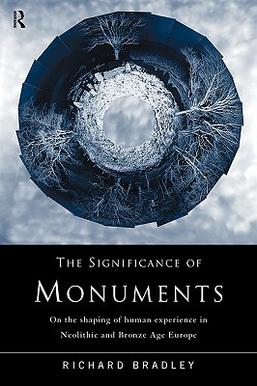
The Significance of Monuments: On the Shaping of Human Experience in Neolithic and Bronze Age Europe is an archaeological book authored by the English academic Richard Bradley of the University of Reading. It was first published by Routledge in 1998.

Prehistoric art in Scotland is visual art created or found within the modern borders of Scotland, before the departure of the Romans from southern and central Britain in the early fifth century CE, which is usually seen as the beginning of the early historic or Medieval era. There is no clear definition of prehistoric art among scholars and objects that may involve creativity often lack a context that would allow them to be understood.

In the Neolithic and Bronze Age British Isles, rock art was produced across various parts of the islands. Petroglyphic in nature, the majority of such carvings are abstract in design, usually cup and ring marks, although examples of spirals or figurative depictions of weaponry are also known. Only one form of rock art in Europe, this late prehistoric tradition had connections with others along Atlantic Europe, particularly in Galicia.

Jacket's Field Long Barrow is an unchambered long barrow located near to the village of Boughton Aluph in the south-eastern English county of Kent. It was probably constructed in the fourth millennium BCE, during Britain's Early Neolithic period. Built out of earth, the long barrow consists of a sub-trapezoidal tumulus flanked by side ditches.
















